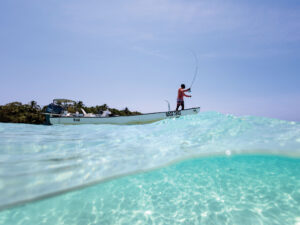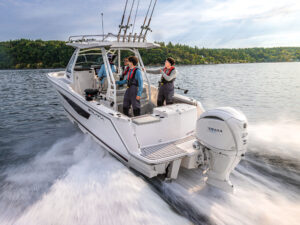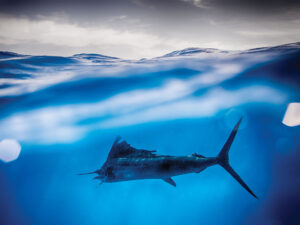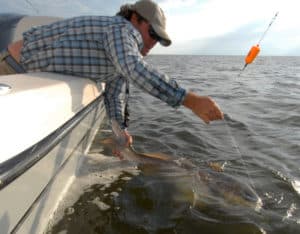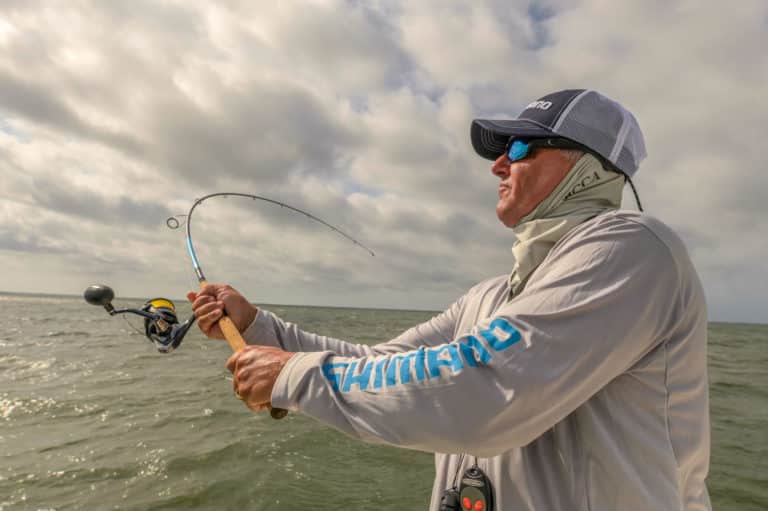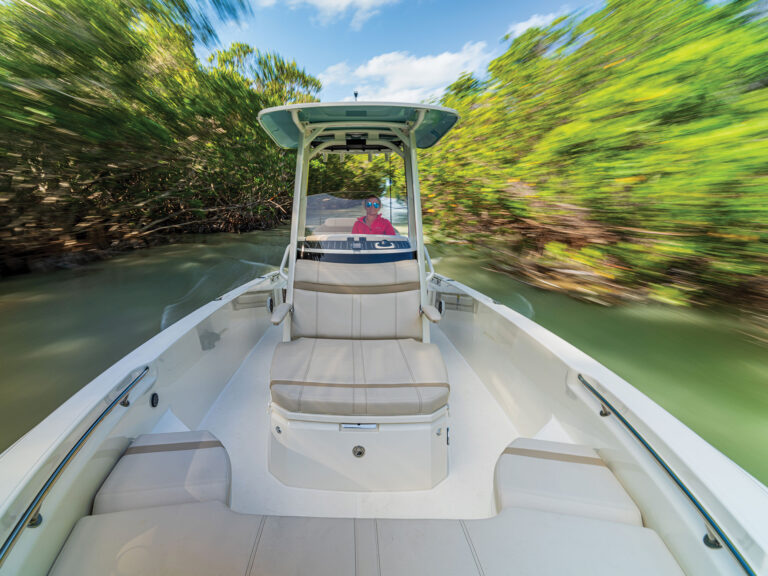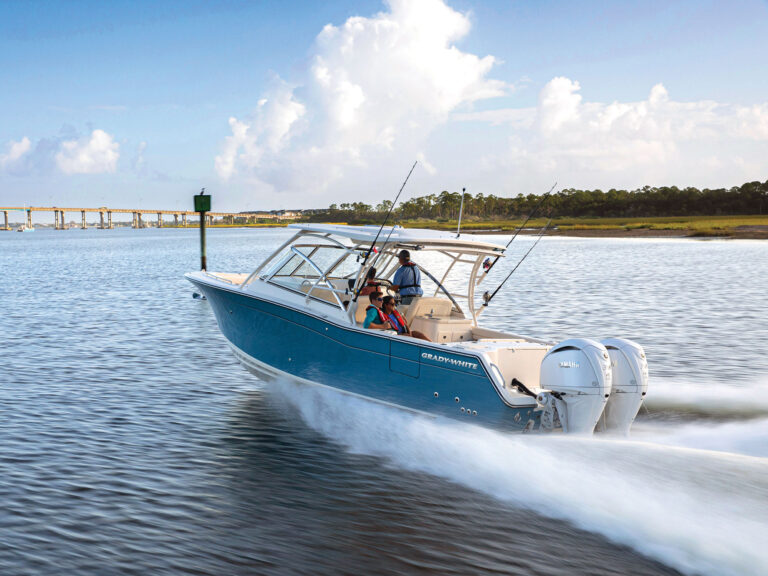
What are the top 100 game fish in the world? Sport Fishing’s unique, authoritative list finally offers the answer.
We asked 61 of the world’s top captains and anglers at the time of our survey to assess 100 saltwater game fish by giving each a quantitative rating.
Our rating system uses eight key indicators of a species’ value as a game fish, assigning a point range to each indicator. The specificity of this system made it quite time-intensive; we are grateful to these experts and appreciate their commitment to this extraordinary listing.
We’ve divided the top 100 game fish into two lists. After you’ve discovered what species occupy numbers one through 50, see the rest of the world’s top game fish — number 51 through 100 — in this gallery.
ALBACORE — #50

Thunnus alalunga Photo by Barry Wiggins; Computer Generated Map for Thunnus alalunga (albacore). www.aquamaps.org
SCORE 50.1 (out of 100 points possible)
Found in all the world’s warm/temperate seas, albacore are sometimes known as “longfin tuna,” thanks to their unique, distinctively long pectoral fins. Marketed commercially for their very white flesh, the species supports popular sport fisheries off California, Oregon and Washington in late summer, as well as off South Africa and elsewhere. Larger albies remain well offshore, often feeding in deep water. The all-tackle record of 88 pounds, 2 ounces came from the Canary Islands in 1977.
Greatest attribute: Stamina
Read more about albacore:
Fishing Washington’s Albacore Alley
Advertisement
BLUEFISH — #49

Pomatomus saltatrix Photo by Jason Arnold / jasonarnoldphoto.com; Computer Generated Map for Pomatomus saltatrix (bluefish). www.aquamaps.org
SCORE 50.5 (out of 100 points possible)
One of only three species in its family, this piranha of the seas can be caught in subtropical and temperate coastal zones around the world. Bluefish are popular with shore and boat anglers alike in southern Australia (where they’re known as tailor), as well as in the U.S. Northeast and mid-Atlantic regions. With a mouthful of razor teeth and a vicious, voracious attitude to match, roving packs of bluefish are slash-and-burn predators that churn through schools of baitfish, boiling the surface. Although it’s hard to beat live bait for blues, as you might suppose, they’re likely to strike anything moving. That has been known to include unlucky or careless anglers’ fingers; caution in the boat is warranted. Fierce fighters, bluefish occasionally jump when hooked. Some anglers find them delicious; others eschew the strong, dark flesh. The all-tackle record of 31 pounds, 12 ounces came from Hatteras, North Carolina, in 1972.
Greatest attribute: Speed (8.9 out of 15)
Read more about bluefish:
BLUEFIN TREVALLY — #48

Caranx melampygus Photo by Doug Olander / Sport Fishing; Computer Generated Map for Caranx melampygus (bluefin trevally). www.aquamaps.org
SCORE 50.5 (out of 100 points possible)
Found in much of the Pacific and Indian oceans, bluefin are one of the most striking of trevallies, unmistakable with their brilliant neon-blue fins, tail and upper-body spots. Bluefin inhabit nearshore reefs and enter harbors, reef channels and lagoons as well. They’re typical of the jack family, in that they aggressively strike lures, jigs, flies and bait, and offer a balls-out, tough fight to the end. The IGFA all-tackle world record is 29 pounds, 3 ounces from Clipperton Atoll (2012); however, Fishbase.org suggests they get larger — much larger, citing a maximum published weight of nearly 100 pounds.
Greatest attribute: Stamina (10.8 out of 15)
Here’s more about bluefin trevally:
RED STEENBRAS — #47

Dentex ruprestris Photo courtesy John Rance; Computer Generated Map for Dentex ruprestris (red steenbras). www.aquamaps.org
SCORE 50.6 (out of 100 points possible)
Porgies are common, generally small, food fishes of tropical reefs worldwide. But red steenbras are giant porgies of frightening proportions, rapacious appetites and impressive power. Their range is limited to the rocky coast and estuaries along the southern part of Africa, where strict laws fully protect the prized — and delicious — slow-growing species today. The IGFA all-tackle-record red steenbras weighed 124 pounds, 12 ounces, taken off South Africa in 1994.
Greatest attribute: Stamina (11.4 out of 15)
Read more about steenbras:
WHITE SEABASS — #46
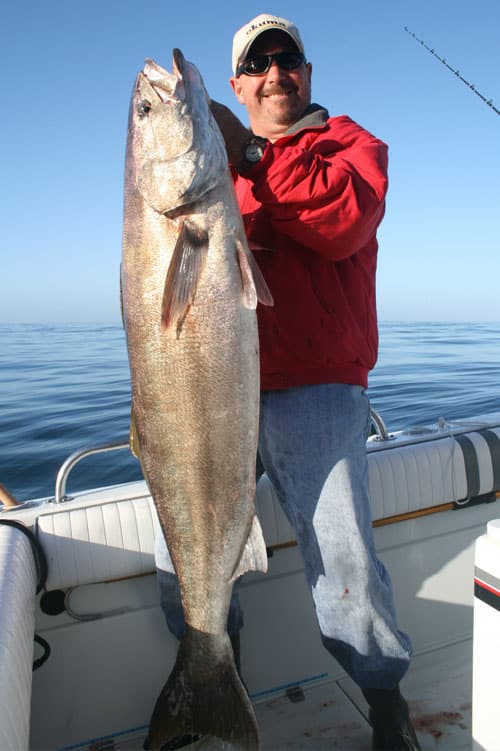
Atractoscion nobilis Photo by Jim Hendricks / Sport Fishing; Computer Generated Map for Atractoscion nobilis (white seabass). www.aquamaps.org
SCORE 51.1 (out of 100 points possible)
One of the larger members of the family of drums and croakers — which includes the spotted seatrout and weakfish of the Atlantic Coast — the white seabass is one of the most coveted saltwater prizes among anglers from northern Baja to central California. It frequents nearshore sandy areas, particularly around kelp beds, feeding on a variety of small baitfish as well as squid and crustaceans. Anglers catch them on a variety of lures and baits, with live squid leading the top of the list. The all-tackle record has been unbroken for more than a half-century: Caught in 1953 off San Felipe, in the northern Sea of Cortez, it weighed 83 pounds, 12 ounces.
Greatest attribute: Fight dynamics (11.9 out of 20)
Read more about white seabass:
KAHAWAI — #45

SCORE 52.6 (out of 100 points possible)
The kahawai (or Australian salmon) is unique to Australia and New Zealand, where it’s an important and highly valued light-tackle and fly-rod game fish among coastal and inshore anglers. Kahawai often gather in large schools to crash bait, à la bluefish. When hooked, they’re nimble fighters, often leaping repeatedly. There is only one genus in the family (Arripidae), with three species. Commonly two to 10 pounds, the world-record kahawai is 19 pounds, 4 ounces, taken in Australian waters in 1994.
Greatest attribute: Fight dynamics (11.2 out of 20)
JACK CREVALLE — #44

Caranx hippos Photo by Michael Patrick O’Neill / mpostock.com; Computer Generated Map for Caranx hippos (jack crevalle). www.aquamaps.org
SCORE 53.0 (out of 100 points possible)
In an odd way, the jack crevalle actually resembles Rodney Dangerfield a bit. In any case, it sure don’t get the respect by many anglers that it deserves, since in reality, few species fight harder or give it their all more than the crevalle. Perhaps their lack of trophy status is because they’re so ubiquitous (they’re abundant throughout much of the temperate and tropical Atlantic, and similarly abundant in the Pacific version) and widely considered inedible (strong, dark, bloody meat). But plenty of anglers do appreciate tough battles with even small “jacks,” as they are often simply known. Jacks don’t jump or tailwalk, but they slug it out to the bitter end. They’re often found in schools, and make top-notch sight-casting targets; few species more readily strike lures and flies. The all-tackle world record was caught in 2010 on the coast of Angola and weighed 66 pounds, 2 ounces.
Greatest attribute: Stamina (12.1 out of 15)
Read more about Jack Crevalle:
CUBERA SNAPPER — #43

Lutjanus cyanopterus Photo by Albain Choinier; Computer Generated Map for Lutjanus cyanopterus (cubera snapper). www.aquamaps.org
SCORE 53.1 (out of 100 points possible)
Brute power — that’s what these giants of the snapper clan are all about. And stopping power is what an angler who would tangle with them needs to have, or he’ll find his quarry back in its reef or wreck in a flash. Atlantic cubera range from deep reefs to estuaries on occasion (especially when smaller). A specialized springtime, full-moon fishery using whole lobsters occurs off Miami and the upper Keys, but the species is found in most warm waters in the western Atlantic. Anglers often hook it incidentally. Slightly smaller Pacific cubera (record: 78 pounds, 12 ounces) lurk over shallower reefs where they’ll come up to strike (explode on) large poppers. Somewhat larger African red snapper (record: 132 pounds, 4 ounces) can be caught from sandy beaches in southwest Africa. The all-tackle Atlantic cubera weighed 124 pounds, 12 ounces, from Louisiana’s Garden Bank in 2007.
Greatest attribute: Stamina (11.7 out of 15)
Read more about cubera snapper:
- Kayak Fishing Panama (where anglers hook huge cubera regularly)
NARROWBARRED MACKEREL — #42

Scomberomorus commerson Photo by Peter Zeroni; Computer Generated Map for Scomberomorus commerson (narrowbarred mackerel). www.aquamaps.org
SCORE 53.1 (out of 100 points possible)
While quite similar to king mackerel, narrowbarred (also called narrowbarred Spanish or often simply “Spaniards” by Australians) grow a bit larger, have a prominent barred pattern on their sides. and skyrocket even more readily on surface-schooling baitfish as well as anglers’ baits and poppers (especially early and late in the day). The leaps might be 20 feet or higher and nearly as far horizontally. When hooked, narrowbarred turn on the afterburners for searing runs. Found throughout the Indian and tropical Pacific oceans, the species is a favorite with many anglers who, typically, catch them while trolling dead or live baits and lures. The all-tackle record, in place since 1982, was caught off South Africa and weighed 99 pounds.
Greatest attribute: Speed (11.7 out of 15)
GREAT BARRACUDA — #41
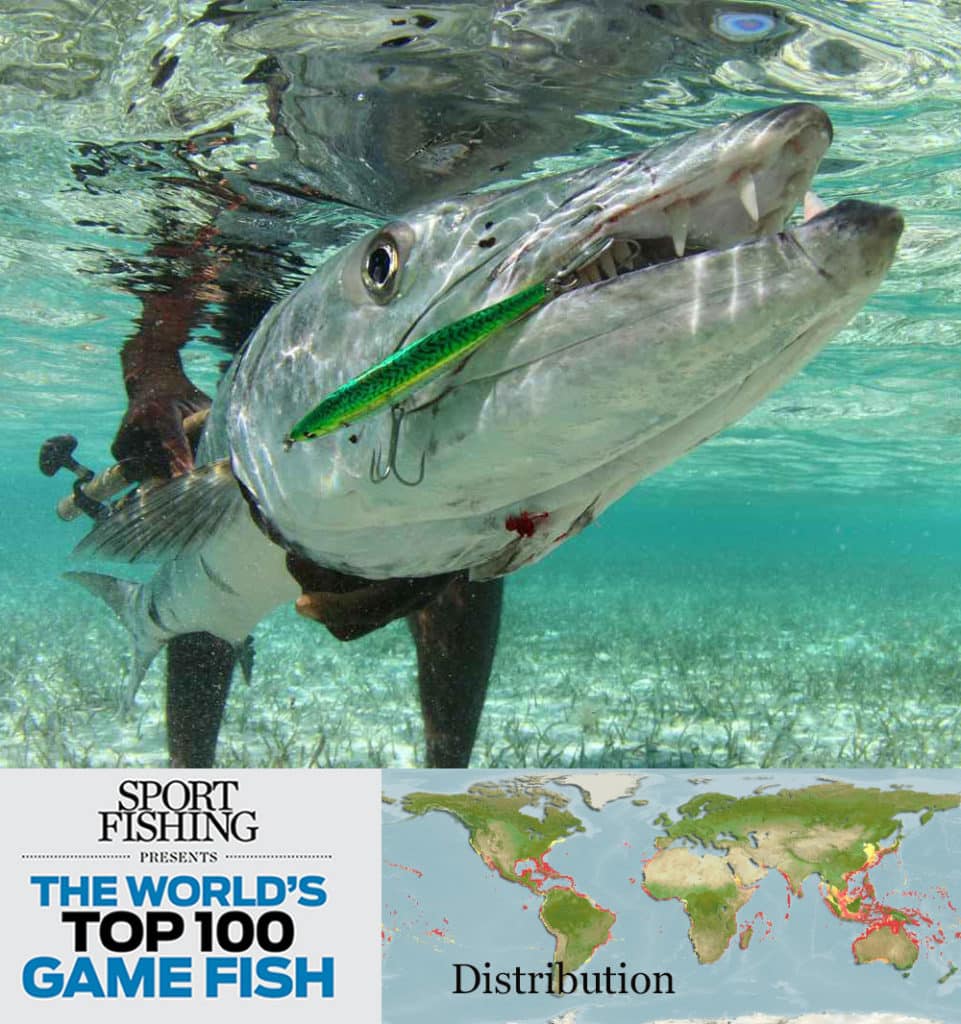
Sphyraena barracuda Photo by Adrian E. Gray; Computer Generated Map for Sphyraena barracuda (great barracuda). www.aquamaps.org
SCORE: 53.3 (out of 100 points possible)
The great barracuda is by far the largest of many species of ‘cudas. It’s found in warm Atlantic waters, particularly the Caribbean, and in the Indo-Pacific region, but is absent in the eastern Pacific off the Americas. Larger ‘cudas hooked in deep water seldom jump, but when hooked over sandy/mangrove flats, they often explode in spectacular leaps. Their flesh is tasty but widely avoided, as it’s frequently implicated in ciguatera poisoning. The all-tackle record of 84 pounds, 14 ounces was caught in 1991 in the Philippines.
Greatest attribute: Dynamics of fight (10.5 of 20)
LEERFISH — #40

Lichia amia Photo by Antonio Varcasia; Computer Generated Map for Lichia amia (leerfish). www.aquamaps.org
SCORE: 53.3 (out of 100 points possible)
Limited to the Mediterranean and tropical eastern Atlantic, the leerfish (aka garrick) is a member of the jack family and, accordingly, a powerful and determined fighter. In appearance, the species is unique and unmistakable. Like many coastal pelagics, the leerfish migrates seasonally. Anglers fish live baits along Atlantic beaches and rocky headlands, both from boats and often from shore. The all-tackle record is 61 pounds, 4 ounces from Spain in 2000.
Greatest attribute: Stamina (10.6 out of 15)
STRIPED BASS — #39

Morone saxatilis Photo by Ethan Gordon; Computer Generated Map for Morone saxatilis (striped bass). www.aquamaps.org
SCORE: 54.2 (out of 100 points possible)
Striped bass are one of a few species on this list that qualifies as an all-American game fish. It’s enormously important along the coast and in estuaries from Maine through the mid-Atlantic states, locally important south into northern Florida; it’s sometimes taken even in northern Gulf of Mexico estuaries. Stripers also thrive in San Francisco Bay and San Joaquin Delta waters, where they were introduced, and a few still hang on in southern Oregon rivers. They’re naturally anadromous but can also thrive landlocked in fresh water. A widely imposed moratorium on any retention in the 1980s helped populations come roaring back after heavy overfishing. A classic game fish that looks, eats and fights great — what’s not to love? The all-tackle world record was recently broken with an 81-pound, 14-ounce brute taken off Long Island Sound in 2011.
Greatest attribute: As a sight-casting target (9.6 out of 15)
Read more about striped bass:
TRIPLETAIL — #54.9

Lobotes surinamensis Photo by Will Drost; Computer Generated Map for Lobotes surinamensis (tripletail). www.aquamaps.org
SCORE: 54.9 (out of 100 points possible)
There’s no other saltwater game fish anything like a tripletail, its shape more like a large sunfish than a sleek predator. But this slab-sided species proves its agility and speed when it suddenly attacks a bait, lure or fly. It also proves its capricious temperament all too often, as saltwater anglers around the world know from tripletail encounters. When spotted finning near buoys or other surface objects, the surface-loving tripletail might turn up its nose at every offering, even live shrimp. When trips do strike, they hit hard, and run and even jump from the water with surprising dexterity. By most standards, tripletail qualify as one of the best eating fish in any ocean. The all-tackle record came from Zululand, South Africa, in 1989; it weighed 42 pounds, 5 ounces.
Greatest attribute: As a sight-casting target (12.4 out of 15)
Read more about tripletail:
BLACKFIN TUNA — #37

Thunnus atlanticus Photo by Doug Olander; Computer Generated Map for Thunnus atlanticus (blackfin tuna). www.aquamaps.org
SCORE: 54.9 (out of 100 points possible)
Widespread throughout the temperate and tropical Western Atlantic, this very accessible and aggressive surface-schooling tuna is a favorite of anglers. When thrashing baitfish or chummed into a frenzy, blackfin are great targets for fly-rodders as well as popper enthusiasts. Although considered good eating, the blackfin is not as choice as its larger relative, the yellowfin. However, their dogged fight is, pound for pound, the equal of any tuna. While footballs of five to 10 pounds are often thick, at times they might run two or three times that size. The all-tackle record is a 49-pound, 6-ounce fish caught off Marathon, in the Florida Keys, in 2006.
Greatest attribute: Speed (12.4 out of 15)
Read more about blackfin tuna:
- Fish the Florida Keys for blackfin in August
- “Busting up Blackfin out of Oregon Inlet”
- Texas Blackfin Tuna Fishing
KING MACKEREL — #36

Scomberomorus cavalla Photo by Doug Olander; Computer Generated Map for Scomberomorus cavalla (king mackerel). www.aquamaps.org
SCORE: 55.4 (out of 100 points possible)
One of the larger mackerels, the king (widely, just “kingfish”) is an everyman’s coastal game fish, found both in large schools and as solitary individuals, from inlets and just off beaches to open nearshore waters. The species is also a booster of coastal economies, particularly via the monstrous SKA (Southern Kingfish Association) tournament circuit. Common from the mid-Atlantic through the Gulf and Caribbean south to Brazil, this coastal pelagic typically follows seasonal migration routes. Light tackle makes even smaller “snakes” a blast, with their sizzling initial runs. Though they don’t jump when hooked, it’s a thrilling sight to see kings skyrocket high into the air when attacking a lure or bait at the surface. Kings in the 10- to 30-pound range are common, but it takes “smokers” of 40 pounds or more to raise eyebrows. The all-tackle world record is 93 pounds, caught out of San Juan, Puerto Rico, in 1999.
Greatest attribute: Speed (12.5 out of 15)
Read more about king mackerel:
- Catching King Mackerel off Cape Canaveral, Florida
- Experts Reveal 12 Secrets for Catching King Mackerel
- Nearshore Tactics for King Mackerel off the Texas Coast
RED DRUM — #35

Sciaenops ocellatus Photo by Doug Olander / Sport Fishing; Computer Generated Map for Sciaenops ocellatus (red drum). www.aquamaps.org
SCORE: 56.1 (out of 100 points possible)
Being one of the most accessible, available game fish over a very large area (from the westernmost Gulf of Mexico to the mid-Atlantic states) helps account for the tremendous popularity of the red drum (aka redfish) among inshore and nearshore anglers. Redfish are found in a great variety of habitats, from clear flats to muddy bays to Atlantic beaches to the base of structure in more than 200 feet of water offshore. They’ll readily strike bait, lures and flies. Their habit of tailing in shallow water and the schooling of bull reds at times in open water off beaches make them a favorite target of sight-casters. Reds hit hard and run strong, particularly in skinny water. They’ve been given game-fish-only status in Alabama, Florida, Louisiana, South Carolina and Texas; in all federal waters, no red drum may be kept by anyone. The all-tackle record weighed 94 pounds, 2 ounces, from North Carolina in 1984.
Greatest attribute: Sight-casting opportunities (12.5 out of 15)
Read more about red drum:
WHITE STURGEON — #34

Acipenser transmontanus Photo by Doug Olander / Sport Fishing; Computer Generated Map for Acipenser transmontanus (white sturgeon). www.aquamaps.org
SCORE: 56.2 (out of 100 possible points)
Living fossils — it’s a description often attributed to these heavily armored bottom feeders with sharklike heterocercal (asymmetrical) tails. Neither the phrase nor their appearance suggest sturgeon would make a good game fish capable of repeated leaps clear of the water — both when hooked and just free-jumping. White sturgeon are anadromous, and often caught in estuaries such as California’s San Pablo Bay and the lower Columbia River between Oregon and Washington, as well as farther up the Columbia and British Columbia’s Fraser River. Their delicate chin barbels and sensitive tubular mouths make them a challenge to hook, usually on crustaceans or small baitfish. The all-tackle record of 468 pounds came from Benicia, California, in 1983. Soon after, and still today, white sturgeon are protected throughout their range with upper size limits that guarantee the world record won’t be beaten. But white sturgeon grow to at least a reported 1,800 pounds!
Greatest attribute: Stamina (11.5 out of 15)
Read more about white sturgeon:
OPAH — #33

Lampris guttatus Photo by Bill Roecker / fishingvideos.com; Computer Generated Map for Lampris guttatus (opah). www.aquamaps.org
SCORE: 56.5 (out of 100 points possible)
The opah surely gets top billing as the least-caught fish on this list. While not rare, these solitary and unique predators of the open ocean’s middepths are nowhere abundant: they patrol waters often too deep for anglers. Off California and Baja, speed jigging with heavy metal jigs accounts for some of those caught on rod and reel — always incidentally, usually when albacore, bluefin or yellowfin tuna are the targets. Opah are found worldwide in tropical to temperate waters and are occasionally caught in the Hawaiian Islands, as well as off California and Baja, and often found in markets; their orange flesh is superb eating. The IGFA all-tackle record was caught in 2014 off San Quintin, Baja. It weighed 180 pounds, 12 ounces, but fishbase.org cites the capture (presumably commercially) of an opah just shy of 600 pounds.
Greatest attribute: Stamina (11.5 out of 15)
Read more about opah:
- California Anglers Land a Triple Header of Opah
- Anglers Are Catching More Opah Than Ever Off Southern California”
DOGTOOTH TUNA — #32

Gymnosarda unicolor Photo courtesy Capt. John Pearce; Computer Generated Map for Gymnosarda unicolor (dogtooth tuna). www.aquamaps.org
SCORE: 59.0 (out of 100 points possible)
There really is no tuna anything like the dogtooth. It’s one of the larger tunas, but unlike yellowfin or bigeye (in fact, the scaleless dogtooth is a species of bonito), it sports a mouthful of daggerlike teeth — and rather than patrolling the high seas in big, predatory schools, the solitary dogtooth prowls slopes and channels through large coral reefs. But it is a tuna and known for its very tunalike endurance when hooked. Dogtooth are found throughout the Indo-Pacific, and readily strike metal speed jigs, baits and trolled lures. The IGFA all-tackle record of 236 pounds, 15 ounces, came from Dar es Salaam, Tanzania, in 2015.
Greatest attribute: Stamina (12.9 out of 15)
Read more about dogtooth tuna:
CALIFORNIA YELLOWTAIL — #31

Seriola lalandi dorsalis Photo by Barry Wiggins; Computer Generated Map for Seriola lalandi dorsalis (California yellowtail). www.aquamaps.org
SCORE: 59.2 (out of 100 points possible)
Mostly geography alone distinguishes the California from the southern yellowtail. In terms of geography, the California subspecies is more limited than most game fish, common only from Southern California south into the Sea of Cortez. The powerful, aggressive jack is a staple of the Southern California fleet, both day boats and long-rangers that find phenomenal fishing along the Pacific coast of Baja where anglers vie for the largest “mossback” yellowtail with live baits and metal jigs (“iron”). Private boaters and kayak anglers tangle locally with yellowtail — considered excellent eating, —along the south coast from spring through fall around structure or kelp. They’re common from 15 to 30 pounds, but the all-tackle world record, from Japan, tipped the scale in 2009 at 109 pounds, 2 ounces.
Greatest attribute: Stamina (12.2 out of 15)
Read more about California yellowtail:
SOUTHERN YELLOWTAIL — #30

Seriola lalandi lalandi Photo by Alistair McGlashan; Computer Generated Map for Seriola lalandi lalandi (southern yellowtail). www.aquamaps.org
SCORE: 60.7 (out of 100 points possible)
There’s not a lot of difference between southern yellowtail and (the next fish in this list) California yellowtail — which are, in fact, the same species but believed to be different subspecies — except size, slightly. The southern variety grows just a bit larger. It’s also found over a much larger area — Southern Hemisphere oceans, both the Pacific (off New Zealand’s North Island and off southeastern Australia, in particular, where they’re known as yellowtail kingfish or just “kingies”) and Atlantic (off southern Brazil and southwest Africa). It’s a member of the jack family, similar in appearance and toughness to amberjack. Two fish tie for the all-tackle world record of 114 pounds, 10 ounces; both were taken off northern New Zealand, one at White Island and the other out of Tauranga.
Greatest attribute: Stamina (12.8 out of 15)
COBIA — #29

Rachycentron canadum Photo by Michael Patrick O’Neill / mpostock.com; Computer Generated Map for Rachycentron canadum (cobia). www.aquamaps.org
SCORE: 60.9
Anglers not intimately familiar with the cobia’s appearance and habits often shout “shark!” when they see one or a group approach a drifting or anchored boat (which cobia very often do, seemingly among the ocean’s more-curious fish species). The resemblance from above is legitimate at a glance, but in fact, cobia are the only species in their own family, unrelated to sharks. Most tropical/warm waters in the world are home to cobia (though oddly, the eastern Pacific is an exception). Tough fighters and delectable eating, cobia are always a welcome addition to any angler’s day. The world record was caught in remote Shark Bay, along the south central coast of Western Australia, and weighed 135 pounds, 9 ounces.
Greatest attribute: A tie — Stamina and as a sight-casting target (both 11.2 out of 15)
Read more about cobia:
BLACKTIP SHARK — #28
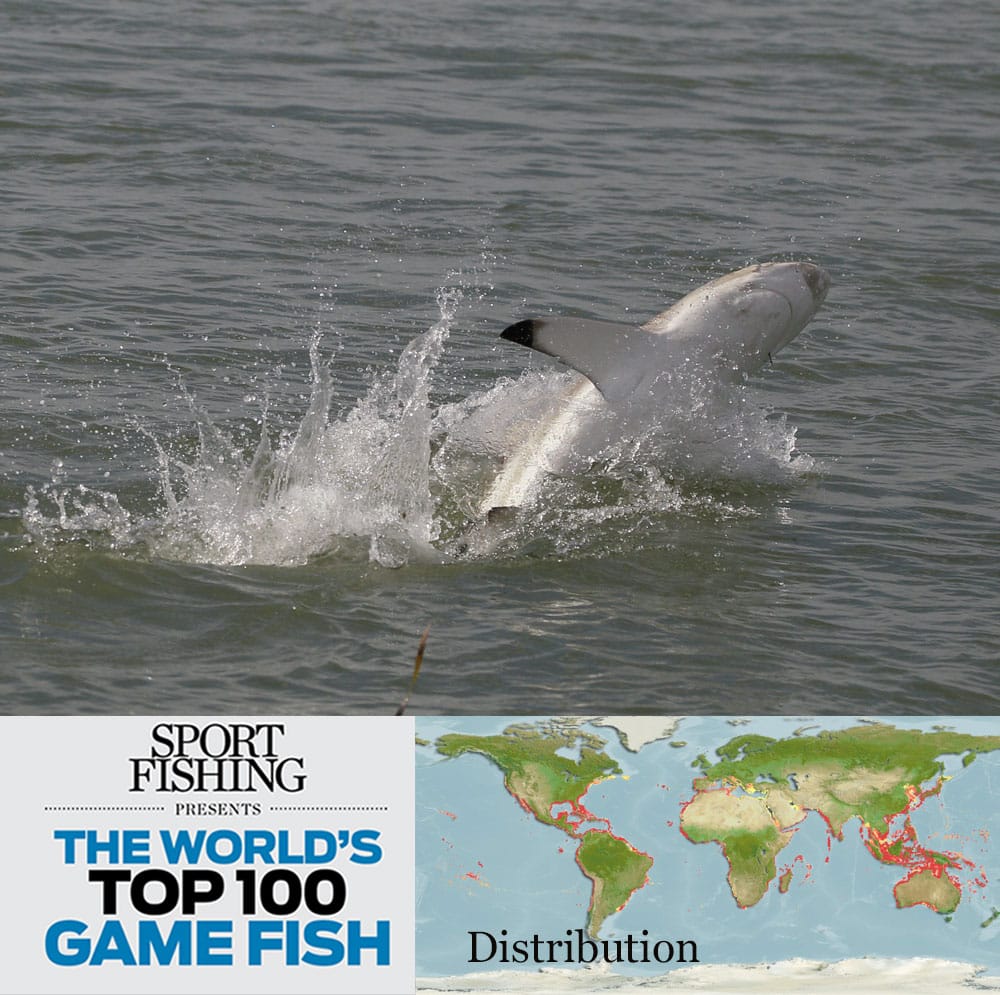
Carcharhinus limbatus Photo by Pat Ford; Computer Generated Map for Carcharhinus limbatus (blacktip shark). www.aquamaps.org
SCORE: 61.1: (out of 100 points possible)
Blacktips are one of the world’s most ubiquitous inshore/nearshore sharks, found around the globe in tropical and temperate waters, in habitats ranging from muddy estuaries to clear coral reefs. They’ll aggressively strike baits, lures and flies, and they make sizzling runs when hooked, often leaping and twisting in the air (as does their close relative, the spinner shark). In areas such as the Florida Keys, blacktips make a popular flats target. Though on the flats they’re usually of modest size, the species can grow large: The all-tackle record, from Malindi Bay in Kenya, weighed 270 pounds, 9 ounces.
Greatest attribute: Stamina (10.6 out of 15)
Read more about blacktip sharks:
BONEFISH — #27

Albula vulpes Photo by Jason Arnold / jasonarnoldphoto.com; Computer Generated Map for Albula vulpes (bonefish). www.aquamaps.org
SCORE: 61.2 (out of 100 points possible)
One of the game fish most coveted as trophies by flats anglers, bonefish are the dragsters of shallow water. At the sting of a hook, they become horizontal missiles, sizzling away on an initial run that lasts far too long and is impossibly fast for a fish of its size. There are several species of bonefish in the world, but the largest is the common bonefish of tropical oceans. There are many outstanding spots in the Caribbean to try for bones, but the Florida Keys remains one of the best bets for big bones. They might move into deeper waters off the flats as well. The IGFA all-tackle record of 19 pounds has held since 1962, when it was caught from the surf off South Africa (though not A. vulpes — another species).
Greatest attribute: As a sight-casting target (14.6 out of 15)
Read more about bonefish
THRESHER SHARK — #26

Alopias spp. Photo by Jason Arnold / jasonarnoldphoto.com; Computer Generated Map for Alopias spp. (thresher shark). www.aquamaps.org
SCORE: 61.3 (out of 100 points possible)
Many species of pelagic sharks look similar, and some might be easily confused, but never the thresher, with a tail about as long as its body. Several species of threshers are found around the world in warm to cool, temperate waters. Some thresher species feed in the upper water column, while bigeye threshers inhabit the depths. Threshers use their tail to herd and stun prey (and are commonly foul-hooked in the tail). With their small mouth and teeth, threshers are not feared as man-eaters, but feed on small fish. They’re stubborn fighters, capable of uncanny bursts of speed, and can make spectacular leaps into the air. Threshers are known to be one of the better-eating sharks. Regulations vary from region to region; for example, the bigeye thresher is protected in Atlantic waters. The all-tackle world-record thresher was caught out of Bay of Islands, northern New Zealand, in 1983; it weighed 767 pounds, 3 ounces.
Greatest attribute: Stamina (11.9 out of 15)
Read more about thresher sharks:
Black Papuan Snapper — #25

Lutjanus goldiei Courtesy Halco Lures
SCORE: 63.4 (out of 100 points possible)
Aficionados of “black bass,” as Papuan black snapper are widely known, often proclaim it the world’s toughest fish. Both its habits and habitat are part of that mystique. The black bass likes to ambush prey in the convoluted confines of downed trees and rugged rocky areas in the current of lower rivers; this powerful, hard-to-stop predator starts its fight amid snags. Adding to its mystique is the species’ limited range: It’s found only in southern Papua New Guinea. The all-tackle world record is 47 pounds, 8 ounces, from Papua New Guinea’s Tauri River in 2015.
Greatest attribute: Fight dynamics (15 out of 20)
Read more about Papuan black bass:
TALANG QUEENFISH — #24

Scomberoides commersonianus Photo by Herle Hamon; Computer Generated Map for Scomberoides commersonianus (talang queenfish). www.aquamaps.org
SCORE: 63.4 (out of 100 points possible)
The queenfish is one member of the jack/trevally family that has it all, including a great aerial show when hooked, making it an ideal light-tackle opponent. The talang queenfish isn’t found in the Americas but is widely distributed about the Indo-Pacific. Australians value them as black marlin baits. Queenies inhabit lagoons (but avoid low-salinity estuaries) and shallow reefs, preferring clear waters. The world-record talang stands at 39 pounds, 7 ounces from South Africa, caught in 2010.
Greatest attribute: Aerial acrobatics (13.7 out of 15)
WAHOO — #23
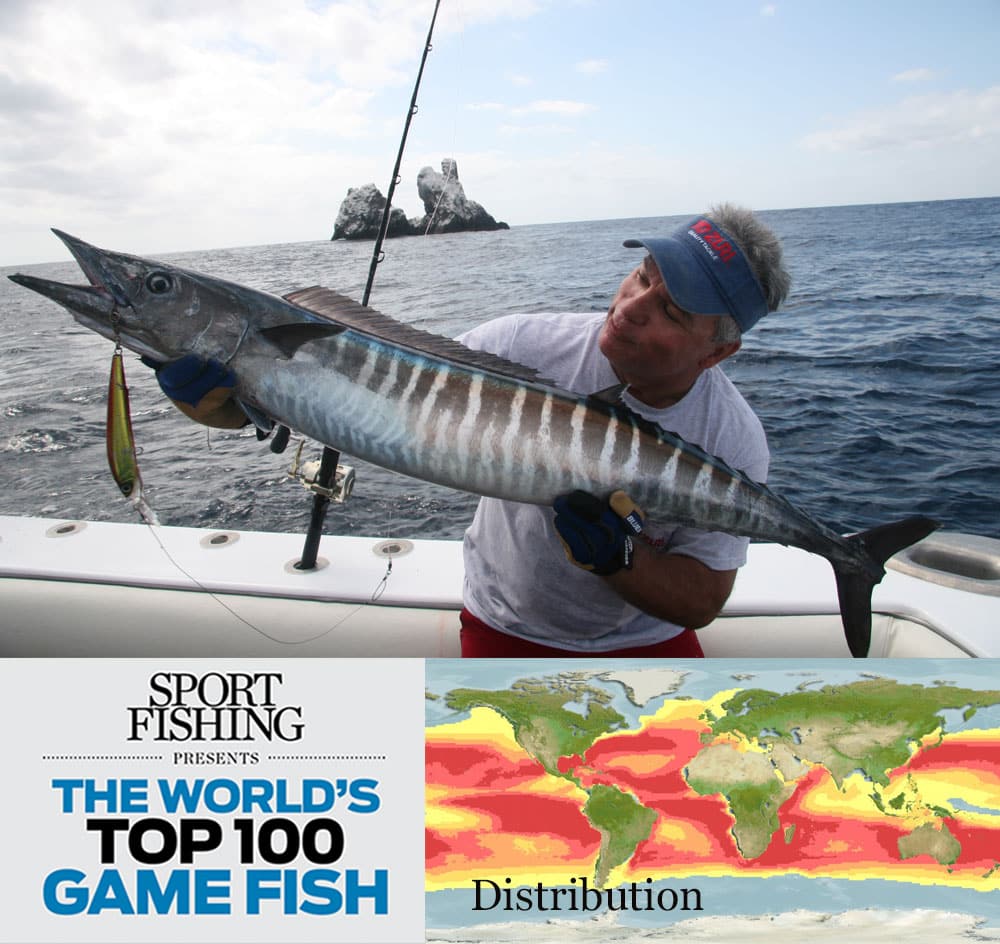
Acanthocybium solandri Photo by Doug Olander / Sport Fishing, Computer Generated Map for Acanthocybium solandri (wahoo). www.aquamaps.org
SCORE: 63.8 (out of 100 points possible)
Built for speed — one look confirms that description of wahoo: torpedoes with fins. Many anglers believe wahoo to be the fastest fish in the sea — and perhaps size for size they are — but in any case, their first run (particularly if on tackle of appropriate size) is simply smokin’ hot. A testament to their velocity: Some wahoo trollers pull lures at speeds exceeding 15 knots. ‘Hoos are found around the world in tropical/warm seas and may travel in packs. They typically patrol near the surface, from blue water far offshore to the edges of steep rocky shorelines and submarine shelves. Hurricane Bank and other areas off Baja provide great numbers of wahoo to long-range anglers. One of the largest members of the mackerel family, wahoo are esteemed for their white flesh. The all-tackle world record weighing 184 pounds was taken off Cabo San Lucas in 2000.
Greatest attribute: Speed (14.4 out of 15; highest rating of any game fish)
Read more about wahoo:
BARRAMUNDI — #23

Lates calcarifer Photo by Doug Olander; Computer Generated Map for Lates calcarifer (barramundi). www.aquamaps.org
SCORE: 64.2 (out of 100 points possible)
It’s easy to see the family resemblance of barra to snook. The barramundi is a bit more thick-bodied and lacks the distinctive lateral-line bar. But the two are clearly kissing cousins in the same genus. Barramundi share all the hard-fighting, high-jumping characteristics of snook, and they get considerably larger. They’re also estuary-based ambush predators, hiding around mangroves or rocks in channels to dart out and snatch a live bait or lure. Barra are found around the upper half of Australia, where they’re the No. 1 inshore game fish, and north through much of tropical Asia. Like snook, these popular game fish are highly regarded for the table. Down Under, barramundi have been stocked in freshwater reservoirs, where they often grow to gimungus proportions. In fact, the all-tackle-record barra, weighing 98 pounds, 6 ounces, was pulled from Lake Monduran in Queensland in 2010.
Greatest attribute: Aerial acrobatics (12.4 out of 15)
Read more about barramundi:
GIANT TREVALLY — #21

Caranx ignobilis Photo by Doug Olander; Computer Generated Map for Caranx ignobilis (giant trevally). www.aquamaps.org
SCORE: 64.2 (out of 100 points possible)
Quick, let’s play word association. I say “giant trevally.” You say — ? If you know much about this species, your immediate response is “Brutal!” or some synonym. One of the largest members of the jack (Carangidae) family, giant trevally (widely known as GT) are quite simply one of toughest fish on rod and reel in the world. Not surprisingly, that challenge attracts anglers far and wide to pit their skills and tackle against big GTs in areas such as Oman, Australia, New Caledonia, the Andaman Islands and Hawaii. GT are common over rugged oceanic reefs throughout the western tropical Pacific and Indian oceans. The frightening power in a GT attack on a popper (which they often demolish before they can be brought to the boat) is unforgettable. Most serious GT enthusiasts use at least 80-pound braid with a locked-down drag to try to stop monsters from powering back over sharp coral reef or bommies. The IGFA world record is an amazing 160 pounds, 7 ounces caught in Japanese waters in 2006.
Greatest attribute: Stamina (13.8 out of 15)
Read more about giant trevally:
SPEARFISH — #20

Tetrapturus spp. Photo by Doug Olander / Sport Fishing; Computer Generated Map for Tetrapturus spp. (longbill spearfish, shortbill spearfish). www.aquamaps.org
SCORE: 64.8 (out of 100 points possible)
The IGFA lumps into two categories these smallest of the billfishes: the shortbill and the Atlantic species. The shortbill spearfish inhabits most of the world’s oceans except for the Atlantic and Mediterranean, inhabited by the longbill, Mediterranean and round-scale spearfishes. Spearfish are seldomly targeted because they’re seldomly found in numbers; they’re typically caught incidentally (and often on tackle too heavy to allow much of a fight, though the novelty of releasing a spearfish is reward enough for many anglers). Kona is one exception; there, shortbills can be around in sufficient quantity for directed fishing by anglers for whom catching one is a goal (often to complete an offshore slam). Besides their small size, spearfishes are characterized by bills quite short compared with other billfishes. The all-tackle record shortbill weighed 110 pounds, 3 ounces; it was caught off Sydney, Australia. The all-tackle record for the longbill spearfish, caught in the Atlantic off the Canary Islands, weighed 127 pounds, 13 ounces.
Greatest attribute: Aerial acrobatics (12.8 out of 15)
Read more on spearfish:
PACIFIC SNOOK — #19

Black Snook and White Snook
Centropomus nigrescens and C. viridis Photo by Doug Olander / Sport Fishing; Computer Generated Map for Centropomus undecimalus (Atlantic snook). www.aquamaps.org
SCORE: 65.0 (out of 100 points possible)
Although six species of Pacific snook inhabit tropical estuaries of the Americas, the two largest — black and white — are of primary interest to anglers. Very similar and not easily distinguished, the species are lumped together by the IGFA for the purposes of records as “Pacific snook.” As with their Atlantic counterparts, a fertile mangrove coast, particularly in lower rivers, offers the best chance to find these elongated predators. In estuaries where local netters fish them hard, Pacific snook populations might be mostly smaller fish; finding lightly fished waters where trophy fish remain can be a challenge. In the eastern Pacific (only), snook range from Baja to Peru (including the Galapagos). The IGFA record Pacific snook is a 59-pound, 8-ounce black caught near Quepos, Costa Rica, in 2014.
Greatest attribute: Aerial acrobatics (12.3 out of 15)
KING THREADFIN — #18

Polydactylus macrochir Photo by Doug Olander / Sport Fishing; Computer Generated Map for Polydactylus macrochir (king threadfin). www.aquamaps.org
SCORE: 65.7 (out of 100 points possible)
Relatively few anglers enjoy the opportunity to catch king threadfin since they’re geographically limited mostly to northern Australia (where they’re often called salmon) and New Guinea. But those who have tangled with threadies recognize the species as “a tornado on a string once hooked, seemingly going in all directions at once,” as the IGFA species’ description puts it, including out of the water. King threadfin live in muddy, silty intertidal waters, where they use their characteristic long filamentous feelers beneath their throat to sense prey. They readily strike lures and bait. Although king threadfin are reported to reach 100 pounds, the IGFA all-tackle record is more modest, at 27½ pounds, from northwestern Australia in 1966.
Greatest attribute: Aerial acrobatics (12.2 out of 15)
COHO SALMON — #17

Oncorhynchus kisutch Photo by Doug Olander / Sport Fishing; Computer Generated Map for Oncorhynchus kisutch (coho salmon). www.aquamaps.org
SCORE: 66.0 (out of 100 points possible)
While considerably smaller (typically five to 15 pounds) than chinook, coho (aka silvers) are more abundant and qualify as one of the world’s great light-tackle gamesters. Coho strike hard and run fast, their fight characterized by sudden shifts in direction and wild leaps. Coho tend to feed higher in the water column than chinook. Naturally abundant, many wild runs along North America have been decimated by human development damming and degrading rivers, though hatchery programs have helped augment recreational fisheries. Coho mix with chinook but can be distinguished in several ways, including the lack of spotting on the lower half of the tail. They range from south-central California, throughout the northern Pacific and in the Great Lakes, where they were introduced decades ago. The all-tackle record, in fact, came from the Salmon River in New York in 1989, weighing 33 pounds, 4 ounces.
Greatest attribute: Aerial acrobatics (12.9 out of 15)
Read more about coho:
CHINOOK SALMON — #16

Oncorhynchus tshawytscha Photo by Doug Olander / Sport Fishing; Computer Generated Map for Oncorhynchus tshawytscha (chinook salmon). www.aquamaps.org
SCORE: 66.7 (out of 100 points possible)
One of the world’s most valuable species commercially and recreationally, chinook (aka king) salmon are easily the largest of six Pacific salmon species. They range naturally from central California to northern Alaska (though introduced into the Great Lakes, South America and elsewhere). Their complex life history involves conditions in the rivers of their birth, where they’ll spawn several years later as well as unpredictable ocean conditions, making management difficult at best. Anglers generally troll for a combination of wild and hatchery chinook, using herring, anchovies, plastic squid (Hoochys) and hard plugs, often on downriggers set at 50 to 200 feet. The IGFA all-tackle record came from Alaska’s Kenai River in 1985, weighing 97 pounds, 4 ounces.
Greatest attribute: Stamina (10.5 out of 15)
Read more about chinook salmon:
- Fishing for Chinook Salmon on Remote Northern Vancouver Island
- Fishing for Chinook Salmon on the Central British Columbia Coast
ROOSTERFISH — #15

Nematistius pectoralis Photo by Adrian E. Gray; Computer Generated Map for Nematistius pectoralis (roosterfish). www.aquamaps.org
SCORE: 66.8 (out of 100 points possible)
The distinctive high, comblike dorsal fin of a lit-up roosterfish cutting through green inshore waters, hot on the trail of a live bait or popper, is one of sport fishing’s most memorable sights. Roosters are unique to the eastern Pacific, where they’re caught from Baja into northern South America. Once thought to be a species of jack (Carangidae), roosters are in fact in their own family. They do, however, certainly fight with jacklike stubbornness and power — but add to that fight the ability to jump, which further explains their appeal as game fish. Roosters are fish of beaches and rocky shores. They can reach weights in excess of 100 pounds, witness the IGFA record since 1960 of 114 pounds from La Paz, Mexico.
Greatest attribute: Sight-casting opportunities (13.9 out of 15)
Read more about roosterfish:
PERMIT — #14

Trachinotus falcatus Photo by Doug Olander / Sport Fishing; Computer Generated Map for Trachinotus falcatus (permit). www.aquamaps.org
SCORE: 67.4 (out of 100 points possible)
Widely considered the most elusive and wary trophy among flats fishermen, permit range throughout tropical waters of the western Atlantic. Other species occur elsewhere, notably in tropical Australia, but T. falcatus is the largest. Permit are a favorite target of fly-fishermen; for those using conventional gear, a live crab or a half-crab gets the best results, since crustaceans form a major part of their diet. When hooked in skinny water, they use their speed and flat sides to full advantage. Permit range widely out to shallow reefs and wrecks, where they might gather in large schools, much less spooky and striking far more aggressively than when stalked on the flats. The all-tackle world-record 60-pounder came from Brazil in 2002.
Greatest attribute: Sight-casting opportunities (13.9 out of 15)
Read more about permit:
YELLOWFIN TUNA — #13

Thunnus albacares Photo courtesy Capt. Josh Temple / primetimeadv.com; Computer Generated Map for Thunnus albacares (yellowfin tuna). www.aquamaps.org
SCORE: 70.2 (out of 100 points possible)
Yellowfin (and the very similar bigeye) tuna are incredibly popular worldwide among sport fishermen, whether running-and-gunning to throw poppers into great breaking schools of 20-pound “footballs,” or fishing kite baits for the world’s largest yellowfin (in the 300- to 400-plus-pound range) off Mexico in the eastern Pacific. The current all-tackle world record is 427 pounds, caught off Cabo San Lucas, Mexico, in 2012.
Greatest attribute: Stamina (14.2 out of 15)
Read more about yellowfin and bigeye:
ATLANTIC SNOOK — #12
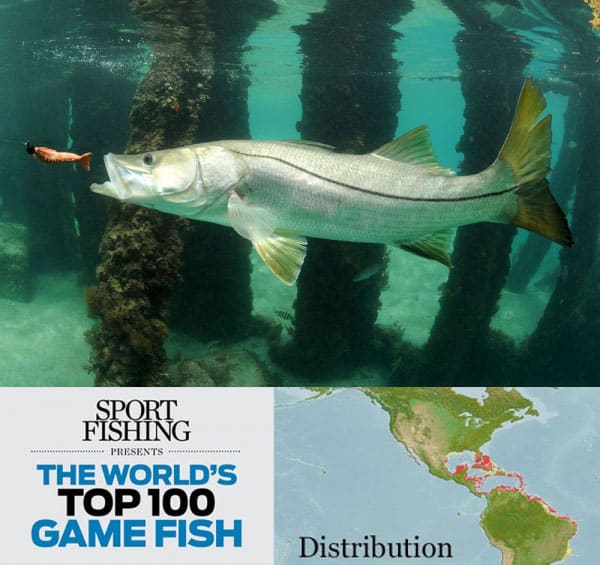
Centropomus undecimalus Photo by Jason Arnold / jasonarnoldphoto.com; Computer Generated Map for Centropomus nigrescens, C. viridis (Pacific snook). www.aquamaps.org
SCORE: 71.4 (out of 11 points possible)
Most of the game fish occupying the top-12 slots in this list are found around much of the world. Not so for snook. That level of interest in fish limited in distribution to a small swath of tropical Atlantic — in shallow coastal waters from southern Florida and Texas south into Central America — says something about the species’ appeal. In fact, there are a half-dozen Atlantic species and as many similar species in the Pacific, but only a few grow large. Snook frequent mangrove estuaries, lagoons and inlets, at times dwelling in fresh water. They explode readily on plugs and flies, and usually put on an exciting aerial display. The underslung jaw and dark lateral-line stripe make snook hard to mistake for anything else. A 53-pound, 10 ounce Atlantic snook has held as the all-tackle world record since 1978, where it was taken in Costa Rica’s Rio Parsimina.
Greatest attribute: Sight-casting opportunities (11.1 out of 15)
Read more about Atlantic snook:
BLUEFIN TUNA — #11

Thunnus thynnus Photo courtesy Capt. Josh Temple / primetimeadv.com; Computer Generated Map for Thunnus thynnus (bluefin tuna). www.aquamaps.org
SCORE: 71.8 (out of 100 points possible)
Only marlin, among all bony fishes, can rival the bluefin tuna as the oceans’ largest predators, and none can rival it in commercial value; large fish can be worth hundreds of thousands of dollars on the Japanese market. The largest bluefin are found in summer and fall off Nova Scotia and Prince Edward Island, where food is abundant and where these endothermic (warm-blooded) giants are able to thrive in the frigid waters. A winter fishery has also developed off the mid-Atlantic coast for giant bluefin. Management of this precious resource by the international agency charged with doing so has been problematic, and stocks remain severely overfished. A Pacific species of bluefin provides anglers off southern Australia and New Zealand with action for fish almost as large. The world-record bluefin has remained unbroken since 1979, when Ken Fraser caught his 1,496-pounder off Nova Scotia.
Greatest attribute: Stamina (14.2 out of 15)
Read more about bluefin:
ATLANTIC SAILFISH — #10

Istiophorus platypterus Photo by Scott Salyers; Computer Generated Map for Istiophorus platypterus (Atlantic sailfish). www.aquamaps.org
SCORE: 77.9 (out of 100 points possible)
Both elegant and iconic, the gorgeous sailfish is an “accessible trophy,” ranging from nearshore to blue waters on both sides of the Atlantic. High-jumping sailfish readily take trolled baits and lures as well as live pitch-baits, and can be teased in to strike large flies. With a widely cited measured speed of more than 68 mph, sailfish are considered the world’s fastest fish. Recent years have seen great numbers of sailfish off southeast Florida, but the largest Atlantic sails prowl the waters off West Africa; the all-tackle world record of 141 pounds, 1 ounce was caught in 1994 off Angola.
Greatest attribute: Aerial acrobatics (18.5 out of 20)
Read more about Atlantic sailfish:
WHITE MARLIN — #9

Tetrapturus albidus Photo by Ken Neill: Computer Generated Map for Tetrapturus albidus (white marlin). www.aquamaps.org
SCORE: 78.1 (out of 100 points possible)
This smallest of Atlantic marlins — typically 50 to 70 pounds — is found in all temperate and tropical areas, where it often comes relatively close to shore. Great jumpers (see video below), whites are particularly popular among anglers in the mid-Atlantic and Northeast states. Its rounded fins distinguish it readily from blue marlin — but not from the round-scale spearfish, so closely resembling white marlin that only a few years ago did scientists realize these were separate species (see first item below). The all-tackle record white marlin weighed in at 181 pounds, 14 ounces; like the world-record blue marlin, it was caught off Vitoria, Brazil.
Greatest attribute: Aerial acrobatics (17.8 out of 20)
Read more about white marlin:
PACIFIC SAILFISH — #8
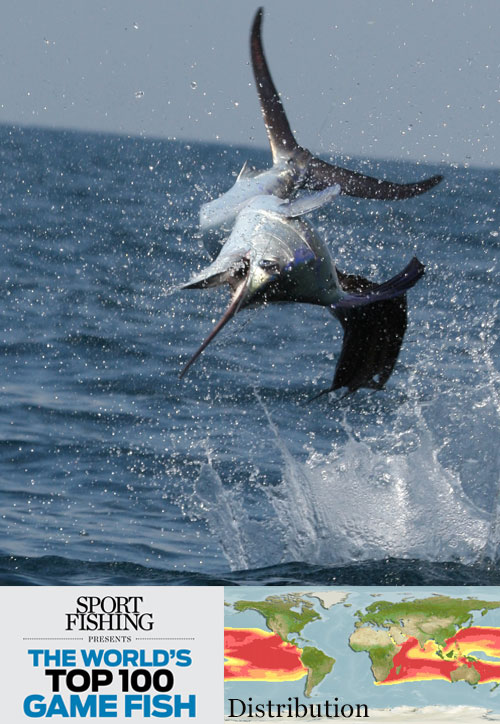
Istiophorus platypterus Photo by Doug Olander / Sport Fishing; Computer Generated Map for Istiophorus platypterus (Pacific sailfish). www.aquamaps.org
SCORE: 78.6 (out of 100 points possible)
Sailfish range throughout warm waters of the Pacific and Indian oceans. I. platypterus tends to run considerably larger in size than does its Atlantic counterpart, with 100-plus-pound fish being run of the mill. The fishery off Guatemala is known to be a leading sailfishery in the world, with some charter boats enjoying dozens of shots in a day. Malaysia’s burgeoning sailfishing in the Sea of China off Kuala Lumpur is another fishery with often-astonishing numbers. The world record has held since 1947: a 221-pounder taken off Ecuador.
Greatest attribute: Aerial acrobatics (18.5 out of 20)
Read more about Pacific sailfish:
SWORDFISH — #7

Xiphias gladius Photo by Doug Olander / Sport Fishing; Computer Generated Map for Xiphias gladius (swordfish). www.aquamaps.org
SCORE: 81.1 (out of 100 points possible)
Arguably the most amazing of the ocean’s apex predators, the swordfish — found around the world in tropical and temperate seas — is often seen basking at the surface (especially in the chilly Pacific off Southern California), and at night hunts in the upper reaches of the water column (where it is taken by trolling lures and bait in geographically disparate areas such as New Zealand and Kenya). Yet much of the time, it prowls the extreme depths — black, cold and with limited oxygen — associating during daylight hours with what is known as the deep-scattering layer, typically 1,500 to 1,800 feet down. Here it feeds on squid and other organisms (aided by heaters that keep its large eyes warm and provide visual acuity). In recent years, protection from longliners by the U.S. government has seen a tremendous surge in populations in the Atlantic off the Southeast and in the Gulf of Mexico. Swords are known for their incredible power and endurance on rod and reel. The world-record broadbill, a 1,182-pound monster, came from the waters off Chile in 1953.
Greatest attribute: Stamina (14.5 out of 15 — the highest ranking game fish of all for stamina)
Read more about swordfish:
MAHIMAHI — #6

Coryphaena hippurus Photo by Doug Olander / Sporf Fishing; Computer Generated Map for Coryphaena hippurus (mahimahi). www.aquamaps.org
SCORE: 81.9 (out of 100 points possible)
“The ideal and arguably most popular offshore game fish: a willing striker, sight-casting friendly, determined and often aerobatic fights, stubborn tendency to sound, great table fare, and beautiful. What else could one want?” George Poveromo’s comment nicely explains the universal popularity of mahi among warm-water offshore anglers around the planet. “The perfect game fish,” says Dave Ferrell, past editor of Marlin Magazine. The flashing neon hues of emerald, peacock blue and brilliant yellow among a lit-up school of rapacious dolphinfish around a boat is both common and extraordinary; there’s nothing quite like it in fishing. Mahi eat insatiably and grow at an astounding rate, up to 18 inches in a year. The all-tackle-record 87-pounder was taken off Papagallo, Costa Rica, in 1976.
Greatest attribute: Aerial acrobatics (17.5 out of 20)
Read more about mahi:
STRIPED MARLIN — #5

Kajikia audax Photo by Brandon Cole; Computer Generated Map for Kajikia audax (striped marlin). www.aquamaps.org
SCORE: 83.7 (out of 100 points possible)
A favorite blue-water target throughout the tropical Indian and Pacific oceans, stripes seldom fail to put on a great show once hooked. The waters off southeastern Baja each fall offer some of the best numbers, while New Zealand is the place for monsters — including the 494-pound world record (1986).
Greatest attribute: Aerial acrobatics (18.0 out of 20)
Read more about striped marlin:
BLACK MARLIN — #4

Istiompax indica Photo by Alistair McGlashan; Computer Generated Map for Istiompax indica (black marlin). www.aquamaps.org
SCORE: 85.9 (out of 100 points possible)
While blue marlin inhabit all warm seas, blacks are strictly limited to the Pacific and Indian oceans. And while blue marlin seldom venture from the deep-blue open ocean, blacks are known to prowl shallow banks and near-coastal waters. Australians often use huge live or rigged dead baits to hook grander blacks, which are also taken off Hawaii, Panama and north into Mexican waters, and elsewhere. Along with the blue marlin, this apex predator is one of the ocean’s ultimate trophies. And the ultimate black to date — the all-tackle-record 1,560-pounder — came from Cabo Blanco, Peru, in 1953.
Greatest attribute: Aerial acrobatics (17.8 out of 20)
Read more about black marlin:
MAKO SHARK — #3

Isurus spp. Photo by Doug Olander / Sport Fishing; Computer Generated Map for Isurus spp. (mako shark). www.aquamaps.org
SCORE: 86.0 (out of 100 points possible)
Few fish strike more awe in the hearts of blue-water anglers than does the mako. The streamlined predator is widely reputed to be the fastest shark; it can turn on a dime, and most amazing of all is its ability to jump. When hooked, makos may leap high into the air — 20 feet or more — and do so, in hang-time somersaults, repeatedly. Longfin and (more commonly caught by anglers) shortfin makos are circumglobal in distribution — found in all tropical and temperate oceans. Their close cousins, the porbeagle and salmon shark, take up residence in colder waters. Makos are excellent eating, but can be dangerous in a cockpit. The all-tackle record mako was caught in 2001 off Massachusetts, and weighed 1,221 pounds.
Greatest attribute: Speed (13.1 out of 15)
Read more about makos:
TARPON — #2
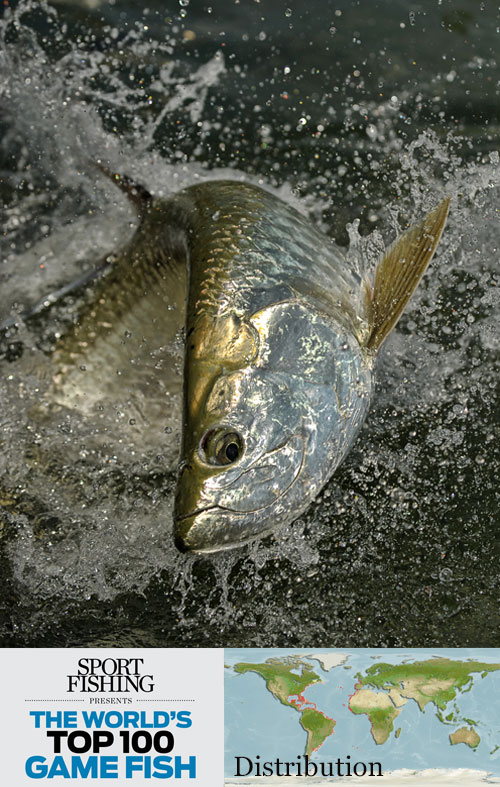
Megalops atlanticus Photo by Jason Arnold / jasonarnoldphoto.com; Computer Generated Map for Megalops atlanticus (tarpon). www.aquamaps.org
SCORE: 87.1 (out of 100 points possible)
While most major game-fish species have similar relatives, the Atlantic tarpon is one of a kind. Found on both sides of the Atlantic, the air-breathing chrome-plated tarpon is an amazing jumper and dogged fighter; it strikes lures, flies and bait. It has recently extended its range by migrating into the Pacific through the Panama Canal; tarpon are now caught regularly off Panama and Costa Rica, and appear to be breeding in the Pacific. Enduringly popular fisheries exist around all of South Florida, and for sheer numbers, Costa Rica’s Rio Colorado is hard to beat. The all-tackle world record — a whopping 286 pounds, 9 ounces — was taken off Guinea Bissau, Africa, in 2003.
Greatest attribute: Aerial acrobatics (18.8 out of 20 — the highest ranking game fish of all for aerial acrobatics)
Read More About Tarpon:
BLUE MARLIN — #1

Makaira nigricans Photo by Adrian E. Gray; Computer Generated Map for Makaira nigricans (blue marlin). www.aquamaps.org
SCORE: 88.9 (out of 100 points possible)
Hooking and releasing a large blue marlin qualifies for many anglers as sport fishing’s greatest challenge, thrill and accomplishment. Blues are caught in oceans around the world on live and dead baits and large trolled lures. Seeing the bill of a big blue in a trolling spread and then watching an amazing display of power as hundreds of pounds of angry billfish repeatedly go airborne, make for angling’s most unforgettable sights. Blue marlin populations are under siege primarily by (often illegal) commercial longline fishing, which is a threat to the species. The all-tackle record for the Atlantic is 1,402 pounds, 2 ounces, caught off Vitoria, Brazil, in 1979. For the Pacific: 1,376 pounds, taken off Kona, Hawaii, in 1982.
Greatest attribute: Aerial acrobatics (18.7 out of 20)
Read more about blue marlin:

